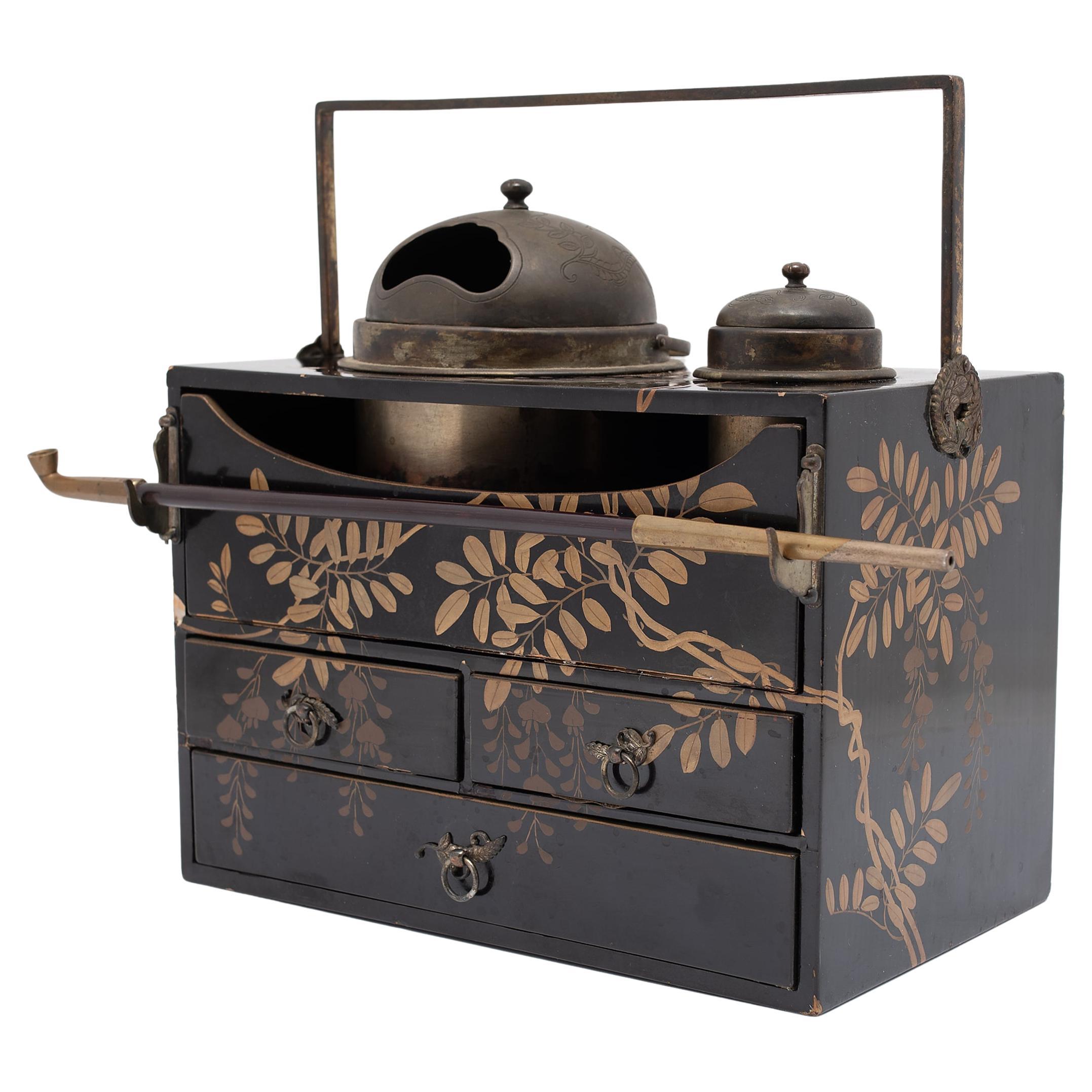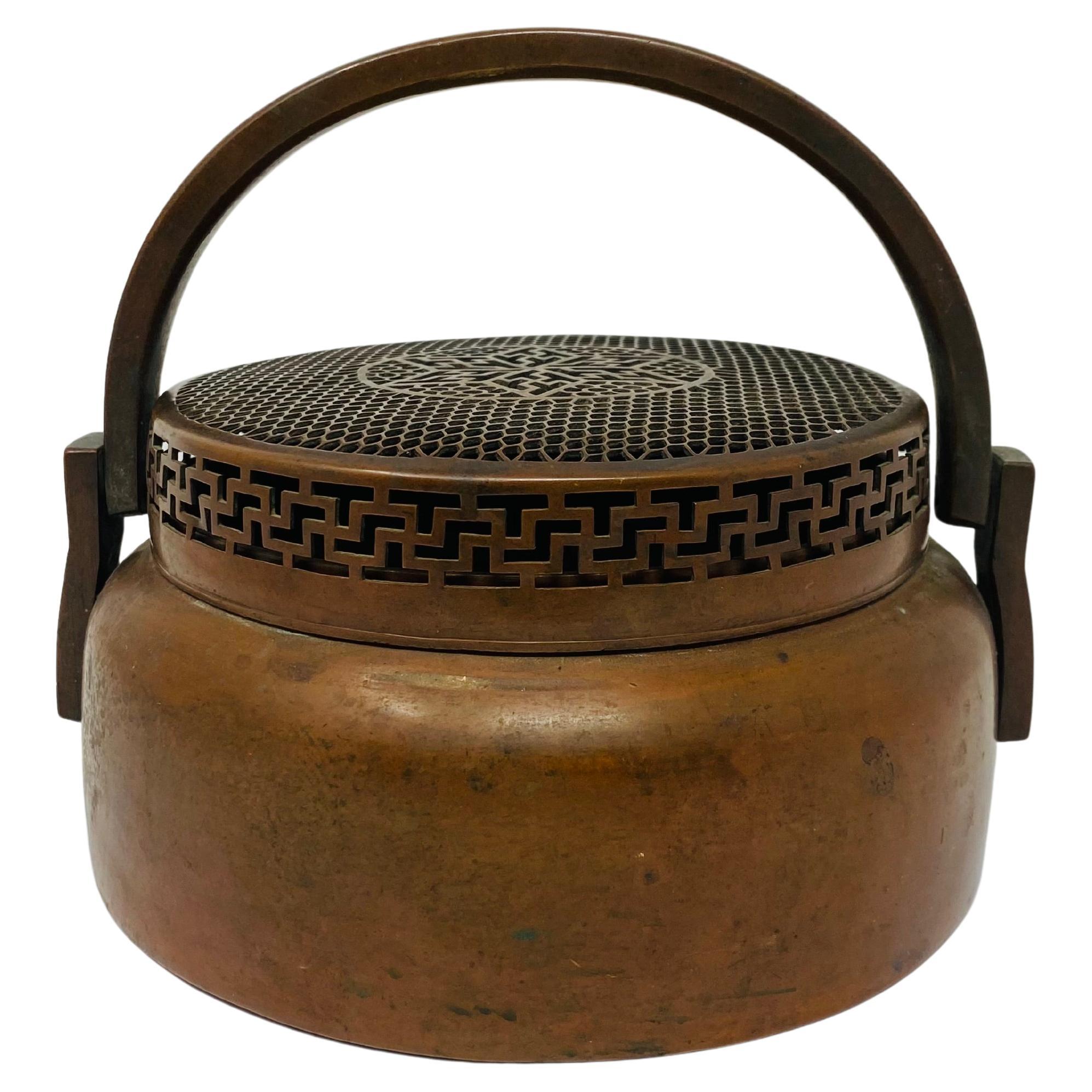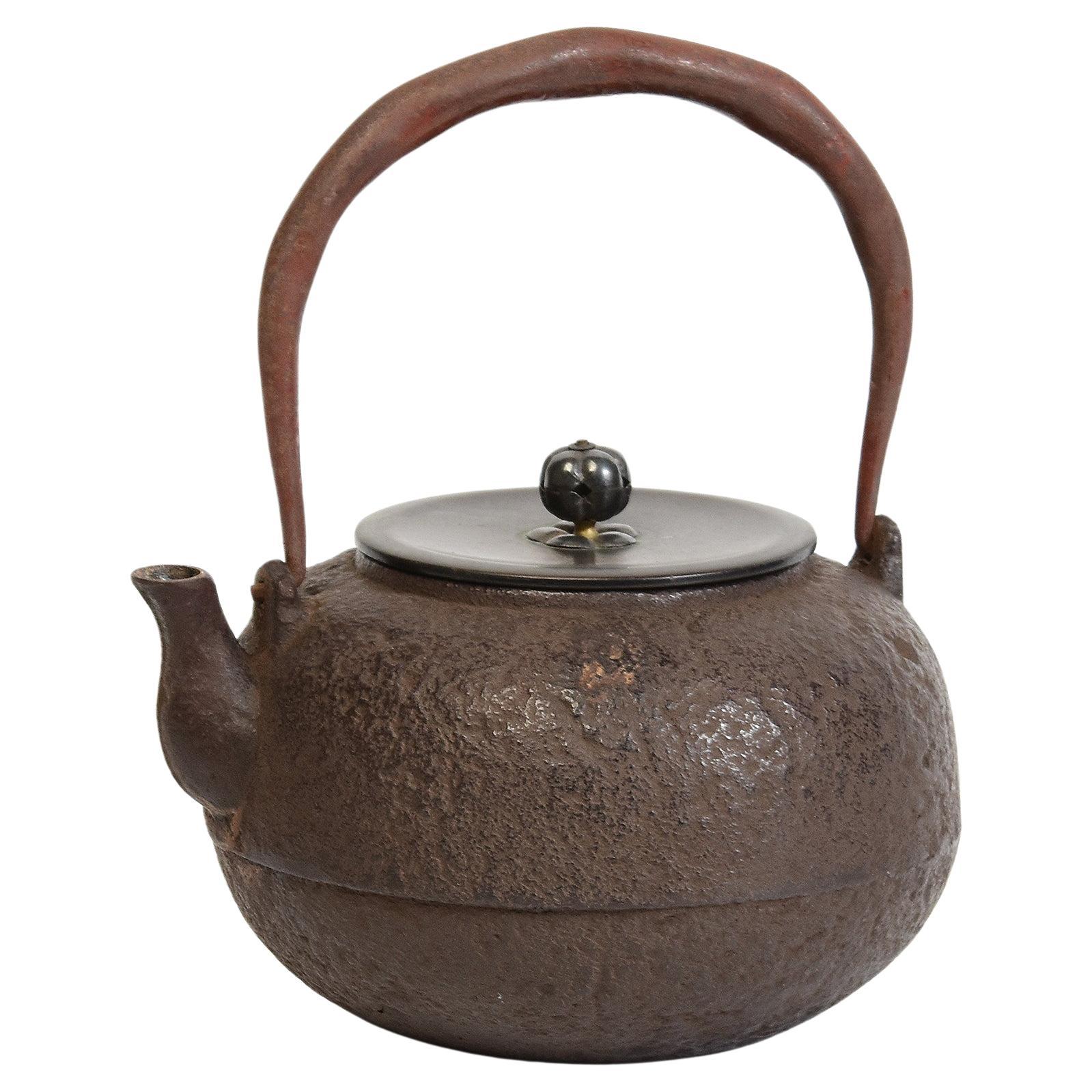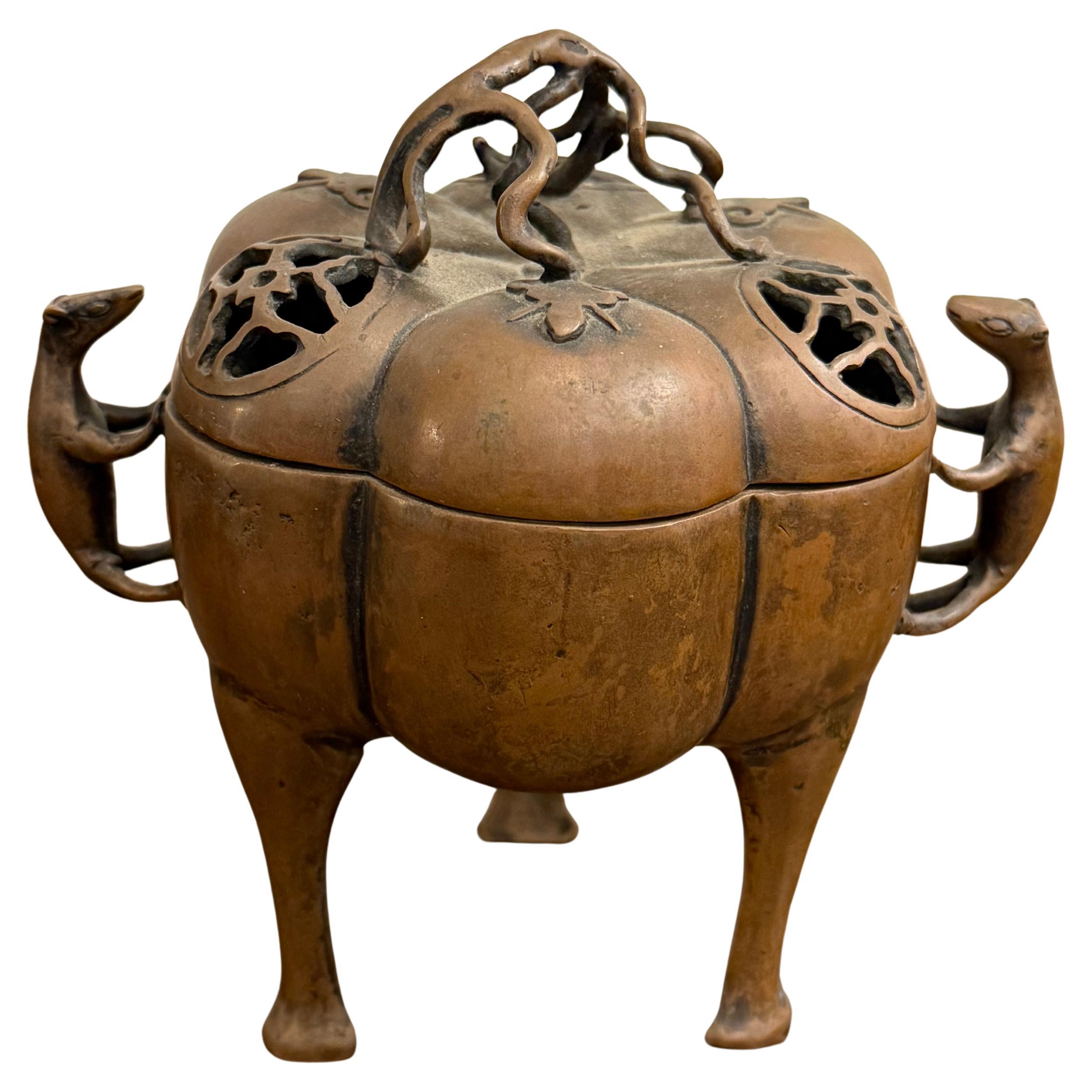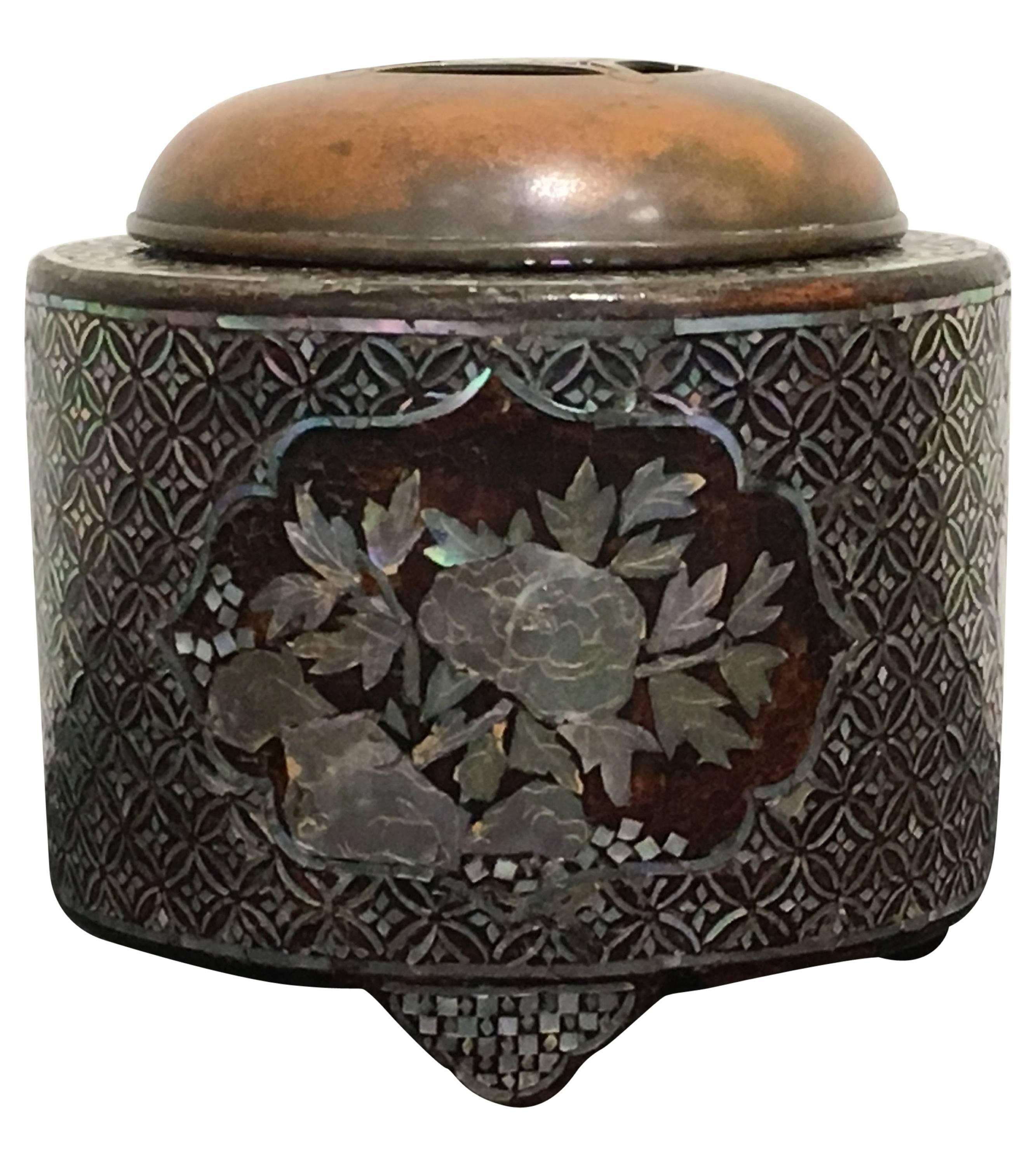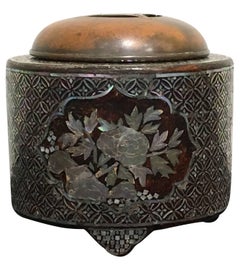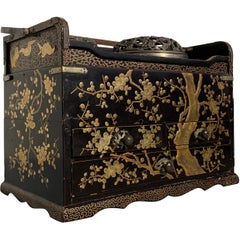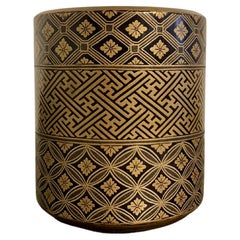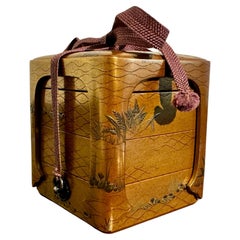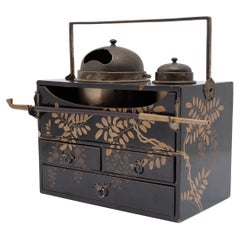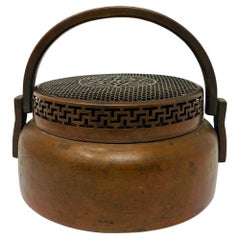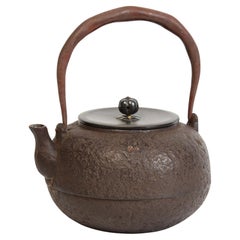Items Similar to Japanese Parcel Gilt Copper Hibachi, Edo Period, 18th Century, Japan
Want more images or videos?
Request additional images or videos from the seller
1 of 18
Japanese Parcel Gilt Copper Hibachi, Edo Period, 18th Century, Japan
$2,800
£2,140.75
€2,465.71
CA$3,923.66
A$4,380.40
CHF 2,295.26
MX$53,620.34
NOK 29,149.84
SEK 27,484.60
DKK 18,401.85
Shipping
Retrieving quote...The 1stDibs Promise:
Authenticity Guarantee,
Money-Back Guarantee,
24-Hour Cancellation
About the Item
A sublime Japanese parcel gilt copper hand warmer, hibachi, with chrysanthemum design, Edo Period, 18th century, Japan.
The hand warmer, called a hibachi, formed as a squat cylindrical vessel with two ears supporting a graceful bail handle over a wide mouth topped by a pierced cover.
The hibachi of hammered copper with a scattered design of carved chrysanthemum blossoms. A wide, flowing band of parcel gilding highlights the carved flowers, reminiscent of Rinpa school paintings.
The cover with a large quatrefoil opening and a pierced geometric design of stylized flowers. Crafted of hammered copper with a large swath of parcel gilding.
The copper with a gorgeous dark patina with a buttery feel. The interior of the hibachi and cover blackened and with signs of heavy use.
The hibachi would have been filled with sand or ash, with charcoal embers placed on top to provide radiating heat. The bail handle on this one would allow it to be carried from room to room with ease.
- Dimensions:Height: 4.75 in (12.07 cm)Width: 7.5 in (19.05 cm)Depth: 7 in (17.78 cm)
- Style:Edo (Of the Period)
- Materials and Techniques:
- Place of Origin:
- Period:
- Date of Manufacture:18th Century
- Condition:Wear consistent with age and use. Minor structural damages. Minor fading. The gilding faded, especially to the cover. A dent and small puncture to the bottom edge. The interior with signs of heavy use. Please see photos.
- Seller Location:Austin, TX
- Reference Number:1stDibs: LU894727647822
About the Seller
5.0
Platinum Seller
Premium sellers with a 4.7+ rating and 24-hour response times
Established in 2001
1stDibs seller since 2010
345 sales on 1stDibs
Typical response time: <1 hour
- ShippingRetrieving quote...Shipping from: Austin, TX
- Return Policy
Authenticity Guarantee
In the unlikely event there’s an issue with an item’s authenticity, contact us within 1 year for a full refund. DetailsMoney-Back Guarantee
If your item is not as described, is damaged in transit, or does not arrive, contact us within 7 days for a full refund. Details24-Hour Cancellation
You have a 24-hour grace period in which to reconsider your purchase, with no questions asked.Vetted Professional Sellers
Our world-class sellers must adhere to strict standards for service and quality, maintaining the integrity of our listings.Price-Match Guarantee
If you find that a seller listed the same item for a lower price elsewhere, we’ll match it.Trusted Global Delivery
Our best-in-class carrier network provides specialized shipping options worldwide, including custom delivery.More From This Seller
View AllJapanese Edo Period Lacquer and Mother-of-Pearl Embellished Stoneware Koro
Located in Austin, TX
A highly unusual Japanese crackle glazed koro (incense burner or censer), lacquered and inlaid with mother-of-pearl embellishment, signed Gyokusen, Ed...
Category
Antique 19th Century Japanese Edo Scholar's Objects
Materials
Copper
Japanese Lacquer Smoking Box, Tabako Bon, Edo Period, 19th Century
Located in Austin, TX
A very fine Japanese maki-e lacquer decorated tabako bon, or smoking box, late Edo Period, mid-19th century, Japan.
The elegant smoking box of black lacquer decorated with a wonderful gold lacquer takamaki-e design of a gnarled and elegantly twisted plum tree with branches in full bloom. A border of golden cranes in flight to the top.
The smoking box, called a tabako bon, is comprised of an open section at the top with inset with two cylindrical metal canisters...
Category
Antique Mid-19th Century Japanese Edo Lacquer
Materials
Lacquer
Japanese Lacquer Incense Burner, Koro, Edo period, mid 19th century, Japan
Located in Austin, TX
An elegant and refined Japanese lacquer koro, incense burner, in the form of a chaire, tea caddy, Edo Perio, mid 19th century, Japan.
The barrel shaped koro formed as a traditional ...
Category
Antique Mid-19th Century Japanese Edo Lacquer
Materials
Copper
Japanese Stacking Incense Box, Ju-Kobako, Meiji Period, Mid 19th century, Japan
Located in Austin, TX
An exquisite small Japanese maki-e lacquer stacking box for incense and accessories, ju-kobako, late Edo or early Meiji Period, mid 19th century, Japan.
Crafted in maki-e lacquer an...
Category
Antique Mid-19th Century Japanese Meiji Lacquer
Materials
Silver
Chinese Archaistic Bronze Tripod Censer, late Qing Dynasty, c 1900, China
Located in Austin, TX
A small and well cast Chinese archaistic bronze tripod incense burner, censer, late Qing Dynasty, circa 1900, China.
The small censer features a squat and bulbous body, very short n...
Category
Antique Early 1900s Chinese Qing Ceramics
Materials
Bronze
Japanese Lacquer Hibachi with Imperial Chrysanthemum, Meiji Period, Japan
Located in Austin, TX
A simple and elegant Japanese lacquer hibachi stand with imperial chrysanthemum mon and copper liner, now modified as an usubata, late Meiji Period, ci...
Category
Antique Early 1900s Lacquer
Materials
Copper
You May Also Like
Japanese Gilt Takamaki-E Tabako-Bon, C. 1850
Located in Chicago, IL
This box with many drawers is a Japanese tabako-bon, or 'tobacco tray,' used to store tobacco and smoking accessories. Believed to have evolved from the t...
Category
Antique Mid-19th Century Japanese Meiji Lacquer
Materials
Brass
Antique Sculptural Copper Chinese Hand Warmer
Located in San Diego, CA
Artistically and visually stunning early 19th Century piece of copper work. This intricate piece is full of detail. The compressed globular body rises to a waisted neck which is co...
Category
Antique Early 1900s Chinese Chinoiserie Metalwork
Materials
Copper
19th Century, Meiji, Antique Japanese Iron Teapot with Bronze Lid
Located in Sampantawong, TH
Antique Japanese iron teapot with bronze lid.
Age: Japan, Meiji Period, 19th Century
Size: Height 19.8 C.M. / Width 17.3 C.M. / Diameter 15.5
Co...
Category
Antique 19th Century Japanese Antiquities
Materials
Bronze, Iron
$1,000 Sale Price
20% Off
A Chinese Bronze Lidded Censer, 19th Century
Located in ARMADALE, VIC
A Chinese Bronze Lidded Censer, 19th Century
Provenance: Private Australian Collection.
Dimensons:
Height: 14cm.
Width: 13cm.
Depth: 9.5cm.
Category
Antique 19th Century Chinese Metalwork
Materials
Bronze
Antique Large Japanese Bronze Mixed Metal Hibachi, 19th Century
Located in Norton, MA
Bronze Mixed Metal Hibachi, Japan, Meiji Period 19th century, the bronze cylindrical body of which is decorated with copper and silver maple leaves. Height 9.5 in. Depth 9.5 in.
Category
Antique 19th Century Japanese Decorative Bowls
Materials
Metal, Bronze
Fine Antique Japanese Patinated Bronze Hibachi
Located in Bridgeport, CT
A square footed hibachi with canted corners and incised key bands on the panels. With wonderful old patina. Mounted on a wood base.
Dimensions: 13 1/2" x 13 1/2" x 12" H
Condition...
Category
Early 20th Century Japanese Japonisme Metalwork
Materials
Bronze
More Ways To Browse
Antique Hand Warmer
Copper Patina Art
Edo Japan
Edo Period Japan
18th Century Copper
Edo Period Japanese Art
Antique Copper Sign
Etched Copper
Edo Period Japanese Painting
Japanese Hand Warmer
Japanese Ash
Bail Handles
Antique Copper Warmer
Japanese Carved Flower
Hammered Copper Signed
Antique Copper Cylinder
Japanese Hibachi
Copper Hibachi
